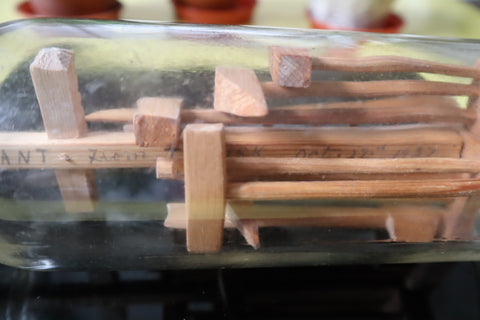Welcome once again to another instalment of 'Blog Post Monday'.
I've had another busy week sourcing new stock for you lovely lot and on my travels, I came across an interesting little curio with subsequent research revealing a rather fascinating little tale. I've decided to dedicate this week's blog post to this special piece of folk art.
So, as always, get that kettle on and gather round, as I regale a folk tale of old...

I stumbled across this fascinating little piece whilst out and about last Tuesday. It had been labelled as a piece of WW2 prisoner of war art, however, I thought I'd seen something very similar before, albeit, the one I'd seen also contained water. Nevertheless, I snapped it up, got it home and began my research.

It soon became apparent that this was what is known as a 'God In A Bottle'. These talismanic bottles are a particular form of Folk Art traditionally associated with the Irish Diaspora living within Mining Communities in the 19th Century.

The bottle contains carved wooden implements of the 'Arma Christi' or the 'Instruments of the Passion'. These represent the following:
1. The Cross on which Christ was crucified
2. The Ladder used for the Deposition
3. The Hammer used to drive nails into Christ’s hands and feet
4. The Pincers used to remove the nails
5. The Holy Lance that Loginus pierced in Christ’s side
6. The Pick-axe and Shovel, two implements used to discourage congregations from working on Days of Obligation following the Black Death.

This particular example appears to be a more recent piece from the first half of the 20th century and based on earlier examples from the 18th and 19th centuries. The maker has hand written with pencil through the centre of the cross, "To Miss M Bryant From T Prisk Oct. 27th 1937".

To my knowledge, these pieces weren't normally signed and this piece is without doubt a gift from Prisk to Bryant in 1937. If you consider that other examples of these bottles contained water, perhaps representing the Psalm that says, "every tear David has cried, God has placed in a bottle". This intimate imagery suggests that God is near in our hurt. The God of the universe, hearing millions of prayers at any given time, is aware of every tear that leaves your eyes.

Suggesting perhaps that Bryant had experienced trauma or loss at the time and Prisk had made and gifted this bottle to her as some form of comfort. If you also take into account that these bottles were traditionally associated with the Irish Diaspora living within Mining Communities, there is the possibility that perhaps Bryant's trauma or loss was linked to mining.

Some quick research did reveal that there were two mining disasters at Markham Colliery in 1937. The first, an underground explosion, claiming the lives of nine men and in the second, 18 miners died and 11 others suffered serious injury when the mechanical brake on a lift carrying them to the coalface failed.

Obviously, I can't prove that there is any link between this bottle, Markham Colliery or either of these disasters, but finding antique and vintage pieces like this that have been personalised, do allow you to paint a picture in your mind and this is why I love this job so much.

If you're interested, this piece is currently available to buy here

Well, that's it for this week folks! I hope you've enjoyed this little insight into British folk art and more specifically, the 'God In A Bottle'. As always, let me know what you think in the comments section below, particularly if you've ever owned an interesting piece of folk art yourself.
Remember, if you enjoy my posts, please show your support by subscribing to my 'Source Social' membership, which you can do via the 'Home' page. It's free and gives you a weekly blog post and a fortnightly YouTube video delivered directly to your inbox, as well as exclusive discounts and first dibs on new items before they are added to our website.
And, speaking of my YouTube channel, if you're into antiques and haven't seen any of my videos yet, you can find them HERE. Head on over and subscribe to that too for your dose of finds, fairs, stories and reviews.
So, until next week, stay safe, keep buying those antiques and keep spreading that Source Vintage love!
Cheerio!
Stephen
Owner Source Vintage
Shop from Source Vintage here
